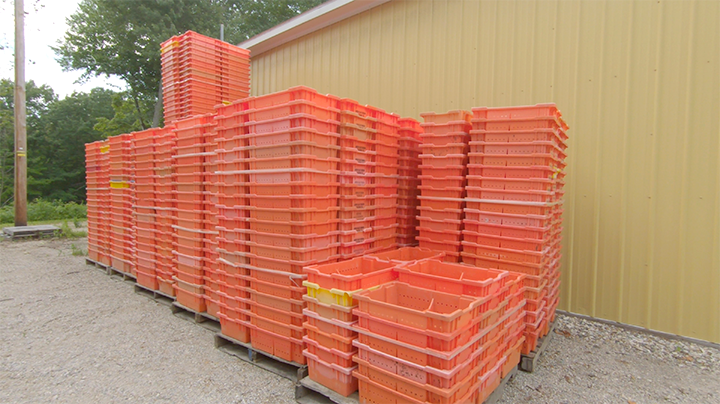Harvest Lug Washing

Newaygo Conservation District Produce Safety Technician

What’s the dirty secret about harvest lug washing? You don’t always have to be cleaning and sanitizing them after each use to be FSMA Produce Safety Rule compliant, but they do have to be maintained in a clean and sanitary condition!
There are several ways to accomplish this. The first is to have enough spare clean harvest lugs on standby to rotate out containers that either get dirty, or have plant residue stains on them. The standard that Produce Inspectors are looking for is ‘free of visible filth’; this generally means that a wet finger or cloth can wipe it away.
A second trick farms have started using to reduce lug cleaning efforts is through supplying a lug cart or tree to workers in the field so that they don’t have to set them on bare ground. A clearly marked lug or what we affectionately call a ‘dead lug’ can also keep clean lugs off the ground.
Lastly, some growers have adopted the use of single-use plastic foam sheeting, which not only pads the lug for the crop being harvested, but also reduces the risk a dirty lug poses as a direct food contact surface -just make sure that the side and top edges are covered!
Something that has been observed by many of us during on-farm produce risk assessments is the persistent gouging caused by lug and harvest container stacking or nesting. These deep scratches trap dirt and grime from plant residues, and are nearly impossible to clean and sanitize without being sanded down. It is thought by food safety microbiologists that these gouges can become a hot spot for soil pathogens like Listeria monocytogenes “L. mono” and Clostridium botulinum “C. bot”. If dark-stained gouges occur on bottoms or inside walls of the harvest lug, these containers are considered unfit for direct food contact. Rotate these bad apples to cull containers on the sorting line, or as ‘dead lugs’ to be used on the ground.
As a last word, make sure to train harvest workers on what the difference is between a clean harvest container and a too-dirty-to-use container. It’s important to train workers on the procedure for marking a bad lug and notifying a supervisor that it needs to get rotated out, so that another harvest worker doesn’t use it by mistake.



 Print
Print Email
Email